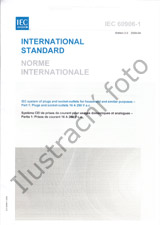Potřebujeme váš souhlas k využití jednotlivých dat, aby se vám mimo jiné mohly ukazovat informace týkající se vašich zájmů. Souhlas udělíte kliknutím na tlačítko „OK“.

IEC 60793-2-70-ed.1.0
Optical fibres - Part 2-70: Product specifications - Sectional specification for polarization-maintaining fibres
Přeložit název
NORMA vydána dne 7.2.2017
Informace o normě:
Označení normy: IEC 60793-2-70-ed.1.0
Datum vydání normy: 7.2.2017
Kód zboží: NS-675357
Počet stran: 19
Přibližná hmotnost: 57 g (0.13 liber)
Země: Mezinárodní technická norma
Kategorie: Technické normy IEC
Kategorie - podobné normy:
Anotace textu normy IEC 60793-2-70-ed.1.0 :
IEC 60793-2-70: 2017 This part of IEC 60793 is applicable to optical fibre types D1, D2, D3, as described in Table 1. These fibres are polarization-maintaining fibre types, and are used or can be incorporated in information transmission equipment and optical fibre cable. These fibres are available for use in optical transport networks. Three types of requirements apply to these fibres: - general requirements defined in IEC 60793-2; - specific requirements common to the category D polarization-maintaining fibres covered in this document and which are given in Clause 4; - particular requirements applicable to individual fibre types or specific applications, which are defined in Annexes A to C. Table 1 – Categories of glass core/glass clad polarization-maintaining fibres
| Category | Type | Description |
| D1 | Polarization-maintaining fibre suitable for use at 980 nm | This category of polarization-maintaining fibre is optimised for polarization-maintaining ability in the 980 nm region. This fibre is used for erbium-doped fibre amplifier. |
| D2 | Polarization-maintaining fibre suitable for use at 1 310 nm | This category of polarization-maintaining fibre is optimised for polarization-maintaining ability and connection property of category B fibres in the 1 310 nm region. |
| D3 | Polarization-maintaining fibre suitable for use at 1 550 nm | This category of polarization-maintaining fibre is optimised for polarization-maintaining ability and connection property of category B fibres in the 1 550 nm region. |
- les exigences generales, definies dans l’IEC 60793-2;
- des exigences specifiques communes aux fibres a maintien de polarisation de categorie D couvertes par le present document et qui sont donnees a l’Article 4;
- des exigences particulieres applicables a des types particuliers de fibres ou a des applications donnees, qui sont definies dans les Annexes A a C.
| Categorie | Type | Description |
| D1 | Fibre a maintien de polarisation convenant a un usage a 980 nm. | Cette categorie de fibres a maintien de polarisation est specialement concue pour le maintien de la polarisation autour de 980 nm. Cette fibre est utilisee pour les amplificateurs a fibre dopee a l’erbium. |
| D2 | Fibre a maintien de polarisation convenant a un usage a 1 310 nm. | Cette categorie de fibres a maintien de polarisation est specialement concue pour le maintien de la polarisation et pour les proprietes de connexion des fibres de la categorie B autour de 1 310 nm. |
| D3 | Fibre a maintien de polarisation convenant a un usage a 1 550 nm. | Cette categorie de fibres a maintien de polarisation est specialement concue pour le maintien de la polarisation et pour les proprietes de connexion des fibres de la categorie B autour de 1 550 nm. |



 Cookies
Cookies
